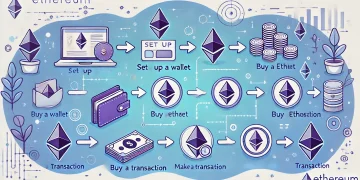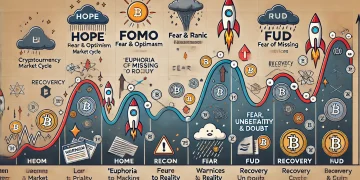Cryptocurrency markets, like all financial markets, move in cycles. These cycles are driven by human emotions, market trends, investor sentiment, and external events. If you’re new to crypto, understanding these market cycles can help you make better decisions, avoid costly mistakes, and ride the waves of volatility like a seasoned investor. In this guide, we’ll explore the different stages of crypto market cycles, from FOMO (Fear of Missing Out) to FUD (Fear, Uncertainty, and Doubt), and provide strategies to navigate each phase.
What Is a Crypto Market Cycle?
A crypto market cycle refers to the patterns of price increases and decreases that occur over time, influenced by investor sentiment, supply and demand, and macroeconomic events. While every market cycle is different, they all share similar emotional stages, beginning with optimism and euphoria and eventually giving way to fear and capitulation.
Stages of a Crypto Market Cycle
Let’s break down the typical stages of a crypto market cycle and explore how investors behave in each phase.
1. Accumulation Phase
The accumulation phase occurs after a prolonged decline or sideways movement in prices, often following a bear market. During this stage, early investors—such as seasoned traders, whales, and institutions—start accumulating coins at lower prices.
- Sentiment: Cautious optimism, skepticism, and indifference from retail investors.
- Key Characteristics: Low trading volumes, minimal media coverage, and little public interest.
- Investor Behavior: Smart money and long-term holders buy assets quietly, preparing for the next bull market.
Pro Tip: This phase is ideal for accumulating coins if you believe the market will recover.
2. Run-Up Phase (Optimism and Belief)
The run-up phase marks the beginning of an upward trend, with prices steadily increasing. Media coverage starts to pick up, and early investors see profits, creating optimism about the future.
- Sentiment: Hope and excitement as more investors believe the market will continue to rise.
- Key Characteristics: Moderate trading volumes, more positive news, and early signs of mainstream interest.
- Investor Behavior: Cautious retail investors begin to buy, though many remain on the sidelines waiting for confirmation.
This phase typically sets the foundation for the coming bull market.
3. Bull Market Phase (Euphoria and FOMO)
The bull market is characterized by rapid price increases and massive gains across most cryptocurrencies. During this phase, prices can skyrocket, often leading to euphoria and FOMO (Fear of Missing Out).
- Sentiment: Overconfidence, excitement, and greed dominate the market.
- Key Characteristics: High trading volumes, heavy media coverage, and public interest at an all-time high.
- Investor Behavior: New investors rush in, buying assets at inflated prices, fearing they’ll miss out on further gains.
Warning: Many inexperienced investors buy at the peak, driven by emotions rather than research, which can lead to significant losses when the cycle reverses.
4. Peak Phase (Market Top)
The peak phase occurs when the market reaches its highest point. Prices become unsustainably high, and some early investors start to cash out their holdings, locking in profits. At this point, euphoria gives way to uncertainty.
- Sentiment: Confusion as prices show signs of slowing down or becoming unstable.
- Key Characteristics: Sharp price fluctuations, conflicting market news, and hints of institutional investors exiting.
- Investor Behavior: Some investors sell for profits, while others hold on, hoping for further gains.
Many retail investors make the mistake of thinking prices will keep rising indefinitely, only to be caught off guard when the decline begins.
5. Correction Phase
The correction phase marks the beginning of a downward trend. Prices start to fall as traders lock in profits, and retail investors begin to panic. Corrections are natural in every market and often serve as reality checks.
- Sentiment: Anxiety, as investors worry about losing their gains.
- Key Characteristics: Moderate declines, rising skepticism, and more cautious trading behavior.
- Investor Behavior: Savvy traders take profits, while others start to panic and sell out of fear.
Corrections are often temporary, but they can signal the transition into a bear market if negative sentiment persists.
6. Bear Market Phase (Fear and Capitulation)
The bear market is the opposite of the bull market—prices fall sharply and stay low for an extended period. Many investors lose faith in the market and sell their holdings, often at a loss, in a process known as capitulation.
- Sentiment: Fear, frustration, and pessimism dominate the market.
- Key Characteristics: Low trading volumes, bad news dominates headlines, and most retail investors exit the market.
- Investor Behavior: Panic selling becomes common, and only the most patient investors hold through the downturn.
Advice: The bear market is where long-term investors accumulate crypto at bargain prices, setting the stage for the next cycle.
7. FUD Phase (Fear, Uncertainty, and Doubt)
FUD is an emotional state that spreads through the market, often fueled by negative news, rumors, or regulatory fears. During this phase, even good news may not be enough to lift prices.
- Sentiment: Fear and uncertainty grip investors, making them hesitate to re-enter the market.
- Key Characteristics: Misinformation spreads quickly, and media outlets focus on negative events.
- Investor Behavior: Many retail investors sell or avoid buying due to fear of further losses.
Pro Tip: FUD often creates buying opportunities for those who can think rationally and recognize when the market overreacts.
Key Emotional Drivers in Crypto Market Cycles
1. FOMO (Fear of Missing Out)
FOMO occurs when investors feel pressured to buy into a rising market, fearing they’ll miss out on profits. This emotion is most prevalent during the bull market phase when prices rise rapidly.
- Impact: Leads to impulsive buying at market peaks.
- Solution: Set a clear investment strategy and avoid chasing hype.
2. FUD (Fear, Uncertainty, and Doubt)
FUD spreads during periods of market instability, often fueled by bad news or rumors. It can result in panic selling, pushing prices even lower.
- Impact: Can lead to irrational decisions, such as selling at a loss during a downturn.
- Solution: Stick to your strategy and do your research before making decisions.
How to Navigate Crypto Market Cycles Effectively
- Avoid Emotional Decisions: Stick to your investment strategy, whether prices are rising or falling. Emotional decisions often lead to poor outcomes.
- Use Dollar-Cost Averaging (DCA): Buy small amounts of crypto at regular intervals to reduce the impact of volatility.
- Take Profits Strategically: During bull markets, it’s wise to take profits along the way to lock in gains.
- Diversify Your Portfolio: Invest in different cryptocurrencies and asset classes to spread your risk.
- Stay Informed: Follow reputable crypto news sources and track market trends to anticipate potential shifts.
- Prepare for Bear Markets: Set aside funds to take advantage of opportunities during market downturns.
FAQs about Crypto Market Cycles
1. How long does a crypto market cycle last?
Crypto market cycles don’t have fixed durations, but they typically span 2-4 years, with bull markets often lasting several months followed by longer bear markets.
2. Can I profit from a bear market?
Yes. Experienced traders can profit from bear markets through strategies like short-selling or by accumulating coins at lower prices for long-term gains.
3. What’s the difference between a correction and a bear market?
A correction is a short-term price drop (usually 10-20%), while a bear market involves a prolonged period of declining prices, often exceeding 20%.
4. How do I know if the market has reached the bottom?
It’s impossible to time the exact bottom of the market. Instead, focus on accumulating assets gradually using DCA during downturns.
5. Should I sell during a market crash?
Selling during a crash locks in losses. It’s often better to stay calm, assess your portfolio, and decide based on your long-term strategy.
6. How can I avoid FOMO?
Set realistic investment goals, avoid chasing hype, and practice patience. Having a clear strategy will keep you from making impulsive decisions.
Understanding the different phases of a crypto market cycle—along with the emotional forces like FOMO and FUD—is essential for making informed investment decisions. While crypto markets are notoriously volatile, those who navigate these cycles wisely can profit over the long term. Keep your emotions in check, stick to a solid strategy, and stay updated with the latest trends to make the most of your crypto journey.


























